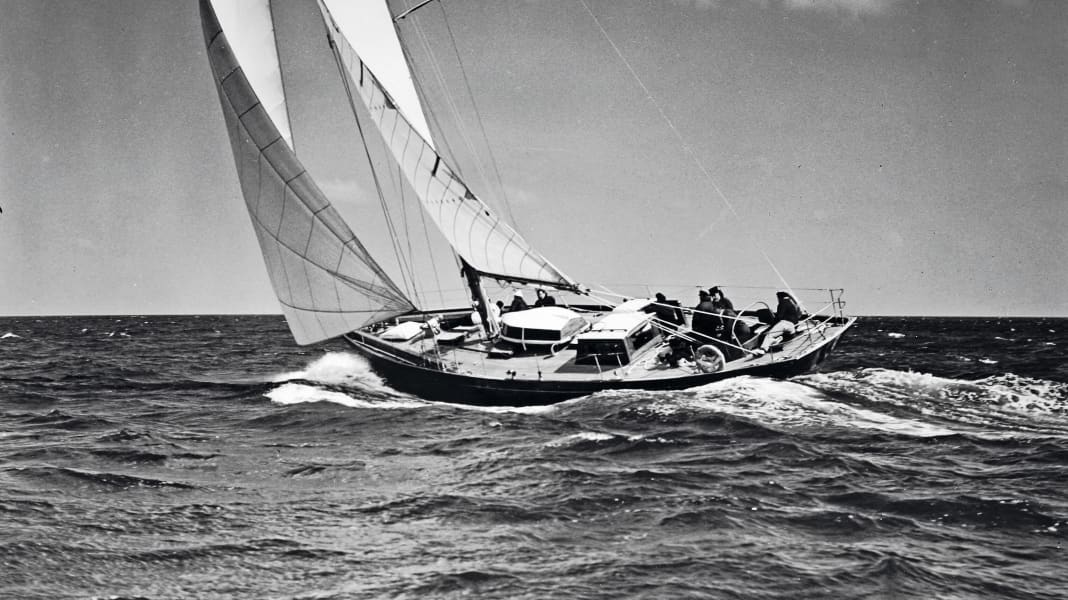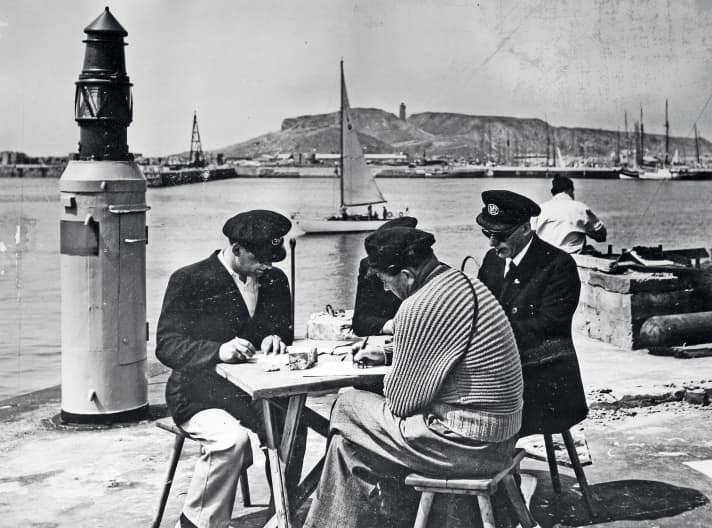
Part 2: The post-war years
Nevertheless, the sailors are there again the following year. Reconstruction is in full swing on the battered rock. There are barracks where once the beds were spared in anticipation of the dawn. But it's all about Heligoland and Skagen, and by next year there are already 100 yachts in the south harbour. Half of them are participants, the other half are onlookers, the so-called "Schlachtenbummler".
The sea cruisers have disappeared. They either did not survive the war or went to England as booty. Remuneration is based on the KR formula. Hans-Otto Schümann is one of the first to commission a competitive yacht based on this design formula. For the 1951 season, the Hamburg native, who later became known as a multiple Admiral's Cup winner and DSV president, had his first "Rubin" built, an 11-KR yacht by Abeking & Rasmussen. In 1953, he was the first person to win the Helgoland Island Prize after the war.
At the beginning of the 1960s, 77 yachts once again register for the North Sea Week. And slowly but surely, the ocean regatta, long regarded as a traditional event, changes its face. In 1962, the first electronic brain is used for the evaluation, and while the Bremen Spreizgaffelketsch "Senta" from 1928 is still the last yacht to start with Pfingstbusch in the top, the first plastic ships are already sailing along.
In 1964, Ernst Burmester's "Aschanti IV", a 35-metre newbuilding in the style of the Newfoundland schooners, set a record in the regatta around Heligoland. After two and a half hours - almost ten minutes ahead of the second, the "Germania VI" - it finished rounding the island. The finish line judges are still sitting at lunch. Only the use of the ambulance can save the situation and bring them to the harbour. The elderly men reach the Molenkopf just in time to take their time. The North Sea Week has really picked up speed.

Burmester had already made North Sea Week history two years earlier. After Heinz Harmssen, he was the winner of the second Heligoland Island Prize in 1962. He had won the first prize four years earlier with his twelve-man "Aschanti III". When the press ran the headline "Racehorse against Ackergaul", the Bremen shipyard owner was so incensed that he had a contemporary 12-KR yacht built by Sparkman & Stephens. The "Dorothee" won him second and third prizes in 1961 and 1962 and later won the coveted prize even more often, five times in total - a record she still holds today.
The year 1968 also brings upheavals for the North Sea Week. The long-distance regatta to Edinburgh is sailed for the first time, which until 2019 alternates with the regatta around Skagen, which has been starting from Heligoland again since 1953. The race will soon be characterised by storms and days of lulls, rolls of fog and seas as high as a house.
And the era of the Cupper casts its shadow ahead: In 1968 and 1969, the North Sea Week is the venue for the regattas for the one-tonne cup. The races are sailed on yachts built and measured according to the RORC formula of the British Royal Ocean Racing Club. In 1967, a yacht flying the German flag, "Optimist", was the winner in Le Havre, skippered by Bremen sailmaker Hannes Beilken. He successfully defended the cup during the 1968 North Sea Week, and Heligoland became the venue for the One-Ton Cup for a second time in 1969, making the North Sea Week part of the international sailing elite.
This article is part of the new YACHT 12/2022, available at newsagents from 1 June or can be ordered digitally.
